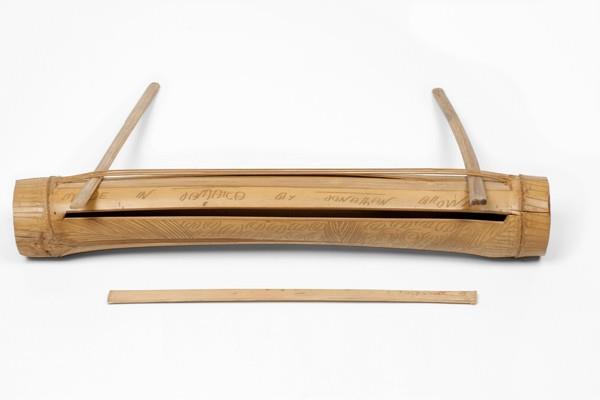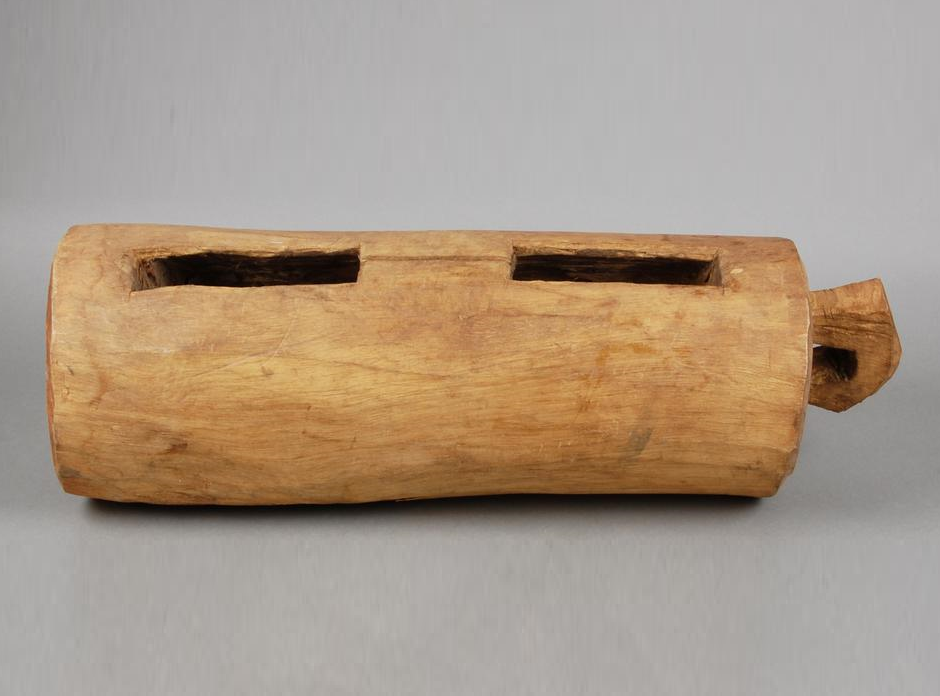Slit Drum
Melodic Percussions
Africa
Ancient
Video
The slit drum, also known as the slit gong, is a fascinating percussion instrument that has been used in various cultures around the world. It is not a true drum because it lacks a drumhead, but rather is classified as an idiophone, meaning it produces sound through the vibration of its material when struck.
Description and Types of Slit Drum
The slit drum is a unique percussion instrument that belongs to the category of idiophones, meaning it produces sound through the vibration of its own material rather than relying on strings or membranes. It is typically made from a hollowed-out wooden log or bamboo tube, with one or more slits carved into its surface. These slits allow the drum to produce different tones when struck with a mallet or the hands. The thickness and length of the wooden slats between the slits determine the pitch and tonal variation of the instrument.
Slit drums come in various sizes and shapes, depending on the cultural traditions of the region where they are made. Some are small and portable, while others are large and require a designated space for playing. The instrument is sometimes referred to as a “log drum” due to its cylindrical shape and natural wooden construction. Unlike conventional drums that use a drumhead, the slit drum relies solely on its resonating chamber and the carefully designed slits to generate sound. This makes it an essential instrument in many indigenous musical traditions around the world.
Types and Features
Slit drums exist in multiple variations, each with distinct features depending on the region and the cultural context in which they are played. Some of the most common types include:
- Single-Slit Drums: These have one slit running across the top, producing a simple yet rich tone when struck. They are often used for basic rhythm patterns.
- Multiple-Slit Drums: These feature multiple slits of varying lengths, allowing for a broader range of tones. This type is more versatile and can be used for melodic playing as well as rhythmic accompaniment.
- Bamboo Slit Drums: Found mainly in Southeast Asia and the Pacific Islands, these are made from large bamboo tubes with slits carved into the surface. They tend to have a sharper, more resonant sound than wooden versions.
- Carved Wooden Slit Drums: Often used in African and Oceanic cultures, these drums are elaborately carved with intricate designs, serving both musical and ceremonial purposes.
Some slit drums are fitted with additional resonators, such as gourds or cavities within the log, to amplify their sound. Their tuning depends on the thickness of the wooden strips and the dimensions of the hollow chamber inside.
History and Origin
Slit drums have a long history and are among the oldest known musical instruments. Their origins can be traced back thousands of years across various continents, including Africa, Asia, the Americas, and Oceania. The instrument’s basic design and function have remained largely unchanged, highlighting its enduring significance in traditional music and communication.
Continent of Origin
Although slit drums are found in multiple cultures, they are most strongly associated with Africa, where they have been used for centuries in ceremonies, communication, and entertainment. The instrument is also prevalent in Oceania, where indigenous communities use it for spiritual and social gatherings. Additionally, variations of the slit drum have been discovered in Central and South America, where they were historically played by indigenous civilizations.
Century of Development
The exact century in which slit drums were first used is difficult to pinpoint, as they predate written history. However, archaeological evidence suggests that they were in use as early as 1000 BCE. Ancient carvings and depictions of slit drums have been found in African and Asian rock art, indicating their presence in early societies. Over time, the instrument spread to different parts of the world through trade, migration, and cultural exchange.
Work Mechanics
The slit drum operates on the principle of resonance and vibration. When a player strikes the surface of the drum with a wooden mallet or their hands, the impact causes the wood to vibrate, generating sound. The slits in the drum act as tonal chambers, allowing air to move within the hollow body and produce different pitches. The placement and width of the slits play a crucial role in determining the instrument’s acoustic properties.
Larger slit drums with deeper chambers produce lower tones, while smaller drums with thinner slats create higher-pitched sounds. Some slit drums are designed to produce two or more distinct notes, enabling musicians to create rhythmic patterns and simple melodies. The playing technique varies by culture; in some regions, players use different-sized mallets to achieve dynamic contrast, while others rely on hand techniques to manipulate tone and volume.
Role in Music
The slit drum serves multiple functions in traditional and contemporary music. In many cultures, it is used as a rhythm instrument, providing the foundation for musical ensembles. Its ability to produce different pitches makes it a valuable tool for creating complex rhythmic structures. The instrument is often played in groups, with multiple musicians using slit drums of different sizes to achieve a layered percussive sound.
Beyond its role in rhythm, the slit drum is sometimes used as a melodic instrument. In certain traditions, musicians tune the slats to specific pitches, allowing for the performance of simple melodies or harmonic accompaniment. This is especially common in African and Oceanic music, where slit drums are played alongside other instruments such as rattles, bells, and stringed instruments.
Significance of Slit Drum
The slit drum holds profound cultural, spiritual, and social significance in many societies. It is not merely a musical instrument but also a means of communication, a symbol of tradition, and a tool for spiritual expression.
Communication and Messaging
One of the most remarkable uses of the slit drum is as a communication device. In many African cultures, it has been used for centuries to send messages across long distances. The rhythmic patterns produced by the drum mimic tonal speech patterns, allowing drummers to convey specific messages. This method was especially useful in pre-modern societies where written communication was limited.
The drum was often used to announce important events such as births, deaths, and gatherings. It could also signal warnings, such as approaching danger or an impending war. The ability to communicate through drumming was a highly specialized skill, and expert drummers were respected members of the community.
Spiritual and Ritualistic Importance
In various cultures, the slit drum plays a central role in religious and spiritual ceremonies. It is commonly used in rituals, initiations, and ancestral worship. The deep, resonant tones of the drum are believed to connect the physical and spiritual worlds, making it an essential instrument in traditional healing and divination practices.
For example, in some African and Oceanic traditions, the slit drum is used to invoke spirits and deities during ceremonies. It is also played during festivals and celebrations to create a sense of unity and collective energy among participants.
Preservation of Cultural Heritage
The slit drum is a symbol of cultural identity and heritage. Many indigenous communities continue to pass down the knowledge of slit drum making and playing from generation to generation. The craftsmanship involved in creating these drums is considered an art form, with intricate carvings and decorations reflecting the beliefs and traditions of the community.
In modern times, efforts have been made to preserve and promote slit drum traditions. Museums, cultural organizations, and musicians are working to document and share the history of the instrument, ensuring that it remains a vital part of the world’s musical heritage.
FAQ
What type of instrument is the slit drum?
The slit drum is classified as an idiophone, meaning it produces sound through the vibration of its material when struck, rather than through a membrane or strings.
What materials are commonly used to make slit drums?
Slit drums are commonly made from wood or bamboo, with the choice of material often depending on regional availability and cultural preference.
What role does the slit drum play in traditional music?
The slit drum plays a significant role in traditional music by adding depth and complexity to musical ensembles. It is also used for communication and storytelling through rhythmic patterns.
 Links
Links
References
Other Instrument
Categories



















